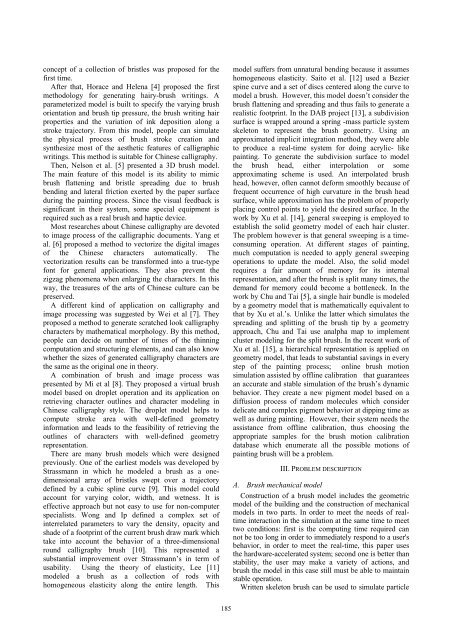Hairy Brush Model Interactive Simulation in Chinese Ink Painting Style
Hairy Brush Model Interactive Simulation in Chinese Ink Painting Style
Hairy Brush Model Interactive Simulation in Chinese Ink Painting Style
You also want an ePaper? Increase the reach of your titles
YUMPU automatically turns print PDFs into web optimized ePapers that Google loves.
concept of a collection of bristles was proposed for thefirst time.After that, Horace and Helena [4] proposed the firstmethodology for generat<strong>in</strong>g hairy-brush writ<strong>in</strong>gs. Aparameterized model is built to specify the vary<strong>in</strong>g brushorientation and brush tip pressure, the brush writ<strong>in</strong>g hairproperties and the variation of <strong>in</strong>k deposition along astroke trajectory. From this model, people can simulatethe physical process of brush stroke creation andsynthesize most of the aesthetic features of calligraphicwrit<strong>in</strong>gs. This method is suitable for Ch<strong>in</strong>ese calligraphy.Then, Nelson et al. [5] presented a 3D brush model.The ma<strong>in</strong> feature of this model is its ability to mimicbrush flatten<strong>in</strong>g and bristle spread<strong>in</strong>g due to brushbend<strong>in</strong>g and lateral friction exerted by the paper surfacedur<strong>in</strong>g the pa<strong>in</strong>t<strong>in</strong>g process. S<strong>in</strong>ce the visual feedback issignificant <strong>in</strong> their system, some special equipment isrequired such as a real brush and haptic device.Most researches about Ch<strong>in</strong>ese calligraphy are devotedto image process of the calligraphic documents. Yang etal. [6] proposed a method to vectorize the digital imagesof the Ch<strong>in</strong>ese characters automatically. Thevectorization results can be transformed <strong>in</strong>to a true-typefont for general applications. They also prevent thezigzag phenomena when enlarg<strong>in</strong>g the characters. In thisway, the treasures of the arts of Ch<strong>in</strong>ese culture can bepreserved.A different k<strong>in</strong>d of application on calligraphy andimage process<strong>in</strong>g was suggested by Wei et al [7]. Theyproposed a method to generate scratched look calligraphycharacters by mathematical morphology. By this method,people can decide on number of times of the th<strong>in</strong>n<strong>in</strong>gcomputation and structur<strong>in</strong>g elements, and can also knowwhether the sizes of generated calligraphy characters arethe same as the orig<strong>in</strong>al one <strong>in</strong> theory.A comb<strong>in</strong>ation of brush and image process waspresented by Mi et al [8]. They proposed a virtual brushmodel based on droplet operation and its application onretriev<strong>in</strong>g character outl<strong>in</strong>es and character model<strong>in</strong>g <strong>in</strong>Ch<strong>in</strong>ese calligraphy style. The droplet model helps tocompute stroke area with well-def<strong>in</strong>ed geometry<strong>in</strong>formation and leads to the feasibility of retriev<strong>in</strong>g theoutl<strong>in</strong>es of characters with well-def<strong>in</strong>ed geometryrepresentation.There are many brush models which were designedpreviously. One of the earliest models was developed byStrassmann <strong>in</strong> which he modeled a brush as a onedimensionalarray of bristles swept over a trajectorydef<strong>in</strong>ed by a cubic spl<strong>in</strong>e curve [9]. This model couldaccount for vary<strong>in</strong>g color, width, and wetness. It iseffective approach but not easy to use for non-computerspecialists. Wong and Ip def<strong>in</strong>ed a complex set of<strong>in</strong>terrelated parameters to vary the density, opacity andshade of a footpr<strong>in</strong>t of the current brush draw mark whichtake <strong>in</strong>to account the behavior of a three-dimensionalround calligraphy brush [10]. This represented asubstantial improvement over Strassmann’s <strong>in</strong> term ofusability. Us<strong>in</strong>g the theory of elasticity, Lee [11]modeled a brush as a collection of rods withhomogeneous elasticity along the entire length. Thismodel suffers from unnatural bend<strong>in</strong>g because it assumeshomogeneous elasticity. Saito et al. [12] used a Beziersp<strong>in</strong>e curve and a set of discs centered along the curve tomodel a brush. However, this model doesn’t consider thebrush flatten<strong>in</strong>g and spread<strong>in</strong>g and thus fails to generate arealistic footpr<strong>in</strong>t. In the DAB project [13], a subdivisionsurface is wrapped around a spr<strong>in</strong>g -mass particle systemskeleton to represent the brush geometry. Us<strong>in</strong>g anapproximated implicit <strong>in</strong>tegration method, they were ableto produce a real-time system for do<strong>in</strong>g acrylic- likepa<strong>in</strong>t<strong>in</strong>g. To generate the subdivision surface to modelthe brush head, either <strong>in</strong>terpolation or someapproximat<strong>in</strong>g scheme is used. An <strong>in</strong>terpolated brushhead, however, often cannot deform smoothly because offrequent occurrence of high curvature <strong>in</strong> the brush headsurface, while approximation has the problem of properlyplac<strong>in</strong>g control po<strong>in</strong>ts to yield the desired surface. In thework by Xu et al. [14], general sweep<strong>in</strong>g is employed toestablish the solid geometry model of each hair cluster.The problem however is that general sweep<strong>in</strong>g is a timeconsum<strong>in</strong>goperation. At different stages of pa<strong>in</strong>t<strong>in</strong>g,much computation is needed to apply general sweep<strong>in</strong>goperations to update the model. Also, the solid modelrequires a fair amount of memory for its <strong>in</strong>ternalrepresentation, and after the brush is split many times, thedemand for memory could become a bottleneck. In thework by Chu and Tai [5], a s<strong>in</strong>gle hair bundle is modeledby a geometry model that is mathematically equivalent tothat by Xu et al.’s. Unlike the latter which simulates thespread<strong>in</strong>g and splitt<strong>in</strong>g of the brush tip by a geometryapproach, Chu and Tai use analpha map to implementcluster model<strong>in</strong>g for the split brush. In the recent work ofXu et al. [15], a hierarchical representation is applied ongeometry model, that leads to substantial sav<strong>in</strong>gs <strong>in</strong> everystep of the pa<strong>in</strong>t<strong>in</strong>g process; onl<strong>in</strong>e brush motionsimulation assisted by offl<strong>in</strong>e calibration that guaranteesan accurate and stable simulation of the brush’s dynamicbehavior. They create a new pigment model based on adiffusion process of random molecules which considerdelicate and complex pigment behavior at dipp<strong>in</strong>g time aswell as dur<strong>in</strong>g pa<strong>in</strong>t<strong>in</strong>g. However, their system needs theassistance from offl<strong>in</strong>e calibration, thus choos<strong>in</strong>g theappropriate samples for the brush motion calibrationdatabase which enumerate all the possible motions ofpa<strong>in</strong>t<strong>in</strong>g brush will be a problem.III. PROBLEM DESCRIPTIONA. <strong>Brush</strong> mechanical modelConstruction of a brush model <strong>in</strong>cludes the geometricmodel of the build<strong>in</strong>g and the construction of mechanicalmodels <strong>in</strong> two parts. In order to meet the needs of realtime<strong>in</strong>teraction <strong>in</strong> the simulation at the same time to meettwo conditions: first is the comput<strong>in</strong>g time required cannot be too long <strong>in</strong> order to immediately respond to a user'sbehavior, <strong>in</strong> order to meet the real-time, this paper usesthe hardware-accelerated system; second one is better thanstability, the user may make a variety of actions, andbrush the model <strong>in</strong> this case still must be able to ma<strong>in</strong>ta<strong>in</strong>stable operation.Written skeleton brush can be used to simulate particle185
















